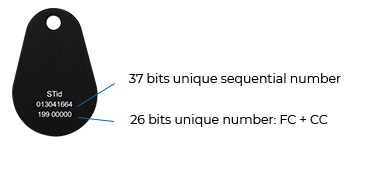

Of facility codes, because the card serial number (like the serial number onĬurrency bills) is never duplicated at the factory. Lately, some formats have a greater number of bits, and make obsolete the notion Number, because the facility code does not match.

Company A will reject Company B cards, and vice versa, even if they have the same card serial To grant access, an access control system validates the facility code AND the serial number. This number can go from 0 to 255 on a 26 bit format card.Īs an example, if Company A has cards numbered from 1 to 1000, with facility code 230,Ĭompany B could have the same serial numbers, but with facility code To reduce this risk, a second number, know as facility or site code is encoded intoĮach card.

But, what if two companies have the same card numbers? They could access each other´s premises. The card number is the read, and compared to that database, to allow or deny access. HID White Paper : Understanding Data FormatsĮvery card has a consecutive serial number encoded, assigned in your access control database to a cardholder. One exception is the HID 37 bit proprietary format, priced similarly to a 26 bit card. However, some of the higher bit formats are "proprietary", and usually carry a higher price tag. Over the years, formats with a higher number of bits (33, 37, 48, 50) have been added to increase card security. Visit our 125khz Proximity Card Selection Guide This 26 bit format is recognized by all access hardware. Card manufacturers suchĪs HID, Indala and AWID sell cards with this format to any dealer. The 26 bit Wiegand format is the more widely used. It is evident that knowledge of the format allows to properly decode the data. But, if we know it is a phone number, we immediately understand that 1 is the country code for USA, 939 the area code, and the remaining digits, the phone number. the format.įor example, if we see a string of numbers, 19395981699, it may mean nothing to us. However, the controller needs to know how the received information is organized., i.e. When a card is waved in front of a reader, those numbers are sent to the access controller.

The number of ones and zeros, and how they are put together, determines the format and ultimately the credential number. A "format" is the structure of the binary data stored in the card. Format and Facility (Site) Code explainedĪ proximity card stores data.


 0 kommentar(er)
0 kommentar(er)
